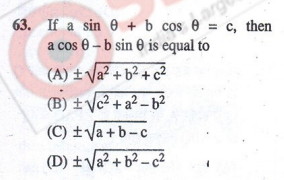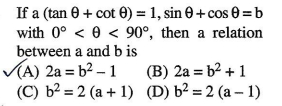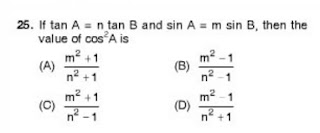Trigonometry is yet another scoring section of CGL. Most of the questions can be solved with jugaad.
Just like Algebra, where we assumed the values of variables, in trigonometry we will assume the value of ‘theta’. And like algebra, make sure the value you are assuming for theta will not make the denominator zero.
How to assume value –
1. When you don’t have to deal with fractions you can assume ϴ = 90 or 0
E.g. (acosϴ – bsinϴ)
2. When fraction is given and putting ϴ = 90 or 0 is making denominator zero, then you can go with ϴ = 45.
3. Don’t assume a value for theta at which the trigonometric function is not defined. E.g. When tanϴ is given, you can’t assume ϴ = 90.
4. When you are assuming two angles, go with A = 60 and B = 30
Note : These are not hard and fast rules and you can assume any value you like, but make sure denominator ≠ 0. Sometimes when you assume ϴ, you may end up with two options(say A and B) that are giving similar results (but two options will still get eliminated, i.e., C and D). Now change the value of theta and check only A and B.
You only need to memorize the values of sin, cos and tan (for ϴ = 0, 30, 45 and 60). The values of cosec, sec and cot can be obtained by reciprocating sin, cos and tan respectively.
Now let’s solve CGL questions
Put ϴ = 90
y = b(1 – 0) = b
Again assume ϴ = 90
Then a*1 + b*0 = cor a = c
You have to find the value of acosϴ – bsinϴ
acosϴ – bsinϴ = -b (Since ϴ = 90)
Now put a = c in all the 4 options to check which one can give ‘-b’ as the output
Assume ϴ = 45
(tanA – secA – 1)/(tanA + secA + 1) = -√2/(2 + √2) = -1/(√2 + 1) = 1 – √2 (rationalize)
Put ϴ = 45 in all the 4 options and check which one will give (1 – √2) as the output
A) √2 – 1
B) √2 + 1
C) 1 – √2
D) √2 – 1
Answer : C
Sometimes you would need to assume two angles
Let A = 60 and B = 30
Then n = 3 and m = √3
cos2A = 1/4 (since A = 60)
Now put n = 3 and m = √3 in all the options and check which one will give 1/4
Answer : B
There is one type of question which is frequently asked by SSC –
When you see secA + tanA = something (let’s say ‘p’) … (1)
you can write, secA – tanA = 1/p … (2)
Now add (1) and (2)
2secA = p + 1/p
secA = (p2 + 1)/2p [You can memorize this formula]
tanA = (p2 – 1)/2p
In the above question, p=2
So secA = 5/4
Now we have to find sinA. The best way to determine the value of a trigonometric function when the value of other function is given, is by making a triangle.
secϴ = Hypotenuse/Base
Here secA = 5/4, hence hypotenuse = 5 and base = 4, which means perpendicular = 3
sinA = perpendicular/hypotenuse = 3/5 = 0.6
Answer : C















